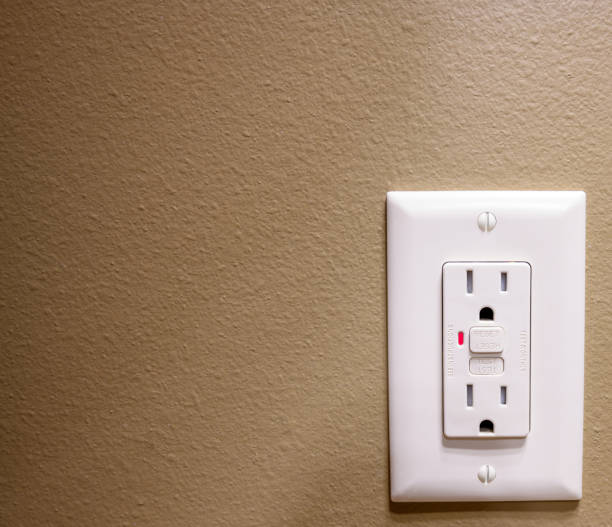
If the GFCI outlets in your bathroom keep tripping, you are not alone. Homeowners in O’Hara Township commonly deal with this issue, especially in the warmer months when humidity tends to build up. Even though GFCIs are designed to protect you, frequent tripping can be frustrating and may signal a deeper electrical problem.
When a GFCI trips, it automatically shuts off power to prevent shock or electrical damage. While that is helpful, figuring out what causes it can feel like a guessing game. The good news is the reasons are often predictable, and once you know what to look for, they are easier to manage. Whether you are tired of constantly resetting the outlet or starting to question your home’s electrical safety, understanding the cause is the first step toward a lasting solution.
Understanding Why GFCIs Keep Tripping
GFCI stands for Ground Fault Circuit Interrupter. These outlets are designed to shut off power instantly when they detect a ground fault or any imbalance in the electrical current. Bathrooms have these outlets because water and electricity do not mix well. They help reduce the risk of electric shock by cutting power before any major danger occurs.
Still, it is important to remember that frequent tripping is not normal. If you notice the reset button on your bathroom GFCI outlet keeps popping out, that is a sign that something is not right. One of the most common causes is excessive moisture. While it is expected in a bathroom, poor ventilation or leaks can lead to water getting inside the outlet or fixture. Even steam from daily showers can create buildup and affect sensitive electrical parts, making the outlet trip more often.
Old, damaged, or miswired circuits can lead to problems as well. If you live in an older home in O’Hara Township, especially one that hasn’t been rewired for a while, there could be hidden wiring issues behind the walls. Loose connections, worn insulation, or DIY fixes from a past owner might be putting too much strain on the GFCI.
Overloading the outlet with too many appliances can also cause a trip. Hairdryers, electric razors, and heated mirrors all demand a lot of power. If two or more are plugged into the same outlet, the GFCI may trip to prevent overheating or excess current.
Tripped GFCIs can signal more than a simple inconvenience. They might point to a deeper hazard hiding behind the walls. Ignoring repeated trips could put your wiring or your home at risk. If the GFCI resets but trips again soon after with no appliance connected, do not assume it is a fluke. It might mean something inside the circuit is deteriorating or dangerously unstable.
Common Causes of GFCI Tripping in O’Hara Township Bathrooms
Homes in O’Hara Township see plenty of moisture, especially with warm summers and older properties that may lack modern ventilation. It only takes a bit of extra condensation from a long shower to make a GFCI sensitive. Beyond moisture, other common reasons can cause outlets to trip unexpectedly in this area.
Here are the top causes of GFCI outlet tripping worth watching for:
– High humidity levels: When bathrooms are not well ventilated, humidity lingers, creating a perfect environment for moisture to sneak into outlets or wiring. This can easily cause false trips.
– Loose or damaged wiring: Connections behind the wall that were poorly installed or have aged over time can send unstable signals to the outlet.
– Overloaded circuits: Running multiple devices like a blow dryer and clothes steamer at once can put pressure on the outlet, prompting a trip to limit potential overheating.
– Faulty appliances: Using a damaged or poorly maintained appliance may cause current leakage, which the GFCI detects as a danger.
– Water intrusion: Leaks from pipes, dripping showerheads, or cracked tiles can allow water to enter the outlet box quietly over time.
Even something as simple as plugging and unplugging devices too frequently or at slight angles might damage wiring inside the outlet over time. If your GFCI outlets are newer but continue to trip with regular use, it could also be a compatibility issue with the circuit they are connected to.
These problems might seem small at first, but they usually indicate that something needs closer inspection. It is always better to catch them early before they lead to electrical damage that puts your home at risk. Knowing what is making the GFCI trip is the first step toward fixing it safely.
Preventative Measures and Tips
If your GFCI outlet has tripped more than once, it is a good idea to identify possible causes before the issue gets worse. While you cannot control O’Hara Township’s summer humidity, you can create better conditions inside your bathroom to reduce moisture buildup. Simple steps like keeping the fan on during and after showers or using a dehumidifier in older homes can make a big difference.
One helpful place to start is with how appliances are used. Avoid plugging in too many high-powered bathroom items at once. Hairdryers, curling irons, and small space heaters can demand more from a circuit than it can safely handle. Using one item at a time helps keep the load on the circuit stable. Even better, unplug devices when they are not in use. This not only saves energy but prevents worn cords from sending signals through the outlet and triggering the GFCI.
Consistent inspections also make a difference. While most homeowners do not look behind outlets themselves, you can still check for things that may signal a problem. These include:
- A reset button that will not stay in place
- A GFCI outlet that feels warm to the touch
- Flickering lights when something is plugged in
- Outlets that spark or smell like burning plastic
- Devices frequently losing power when connected
If you are seeing any of those signs, stop using the outlet right away until it can be checked. Bathroom outlets go through more wear and tear than outlets in other parts of the house, so keeping track of their condition is important. GFCI outlets do not last forever. Replacing them every 7 to 10 years, or sooner if they show signs of failure, helps lower the chances of trips and electrical hazards.
Finally, do not overlook the importance of safe ventilation. Bathrooms that stay damp for too long create more risk. Leaving the door cracked open after a shower or installing a better exhaust fan can push moisture out faster, helping circuits stay dry and stable.
When to Call Our Professionals
If you have reset your GFCI and it keeps tripping repeatedly, it may point to a deeper problem that cannot be fixed from the outside. At this point, guessing what is wrong could make things worse. A trained electrician can check inside the outlet box, test the wiring, and track down issues not visible from the surface.
You will know it is time to call our professionals if:
- The outlet trips even with nothing plugged in
- The reset will not stay engaged after several tries
- You hear buzzing or crackling from the outlet
- Multiple outlets in the room are losing power at once
- You have noticed flickering lights or power surges elsewhere in the house
O’Hara Township homes, especially ones built before the 1990s, can have wiring problems that are not visible until something like a GFCI trip sheds light on them. Even newer homes can have outlets wired incorrectly or overloaded circuits that were not designed to handle today’s devices. Our technicians can find the source of the issue and let you know what should be fixed or upgraded.
Fixing a tripping GFCI involves more than just replacing the outlet. It includes checking the load on the circuit, finding moisture paths, and making sure every connected wire is grounded properly. Those are all tasks that require expert attention. Leaving electrical repair to trained professionals is the safest way to get your bathroom back to normal.
Ensuring Long-Term Safety
Once the immediate tripping problem is solved, keeping your bathroom safe means being proactive. Make electrical inspections a regular part of your home maintenance schedule, especially before summer when humidity rises in O’Hara Township. Annual or even twice-yearly checks can catch small problems before they turn into large failures.
Teach everyone in the home how to recognize warning signs. Guests and kids may not know the difference between a standard outlet and a GFCI. Make it a habit to unplug appliances after use and make sure hands are dry before touching electrical cords. These small steps add up and help keep the system steady.
Planning upgrades to your system also helps prevent future issues. If your bathroom has only one GFCI outlet, it might be time to install an additional one on a separate breaker. That spreads out the electrical demand and lowers the frequency of trips. A qualified electrician can take a look and recommend smart changes based on how your family uses the space.
For homeowners in O’Hara Township, dealing with GFCI trips often points to signals being missed earlier on. Sticking to maintenance, reducing moisture, and knowing when to bring in our professionals can keep your home safer. A working outlet means more than power—it provides peace of mind that your home is protected.
Persistent GFCI trips can present a serious risk to your home’s electrical safety if not properly addressed. Working with experienced electricians in O’Hara Township can help identify and fix underlying issues like faulty wiring or moisture exposure before they lead to greater hazards. Supreme Heating and Cooling provides trusted expertise and clear, effective solutions to keep your electrical system operating safely year-round. For a quick estimate or to book a service visit, please contact us today.

.svg)

.webp)


.svg)
.webp)
.svg)
